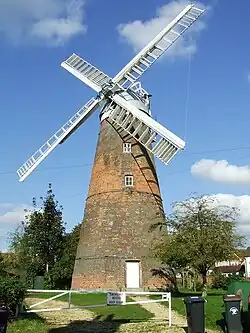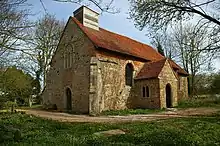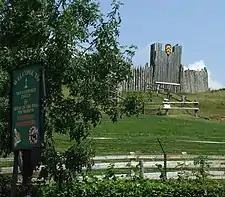Scheduled monuments in Essex
There are 425 scheduled monuments in the county of Essex, England.[1] These protected sites date from the Neolithic period and include barrows, moated sites, ruined abbeys, castles, and a windmill.[2] In the United Kingdom, the scheduling of monuments was first initiated to insure the preservation of "nationally important" archaeological sites or historic buildings. The protection given to scheduled monuments is given under the Ancient Monuments and Archaeological Areas Act 1979[3]
Notable scheduled monuments in Essex
| Image | Name | Location | Date | Notes |
|---|---|---|---|---|
 |
Colchester Castle | 51.890589°N 0.903047°E | 1st century AD – 11th century AD | The monument includes a Roman fort, the remains of a Roman settlement, a classical temple, a late Anglo-Saxon chapel and a Norman castle.[4] |
 |
Hadleigh Castle | 51.5444°N 0.6090°E | After 1215 AD | This is the only surviving example of an enclosure castle in Essex and an associated dam and watermill.[5] |
 |
Hedingham Castle | 51°59′33″N 0°36′04″E | Late 11th-early 12th century | A ringwork castle and tower-keep. It is the best example of a Norman tower-keep in England.[6] |
 |
The Leper Hospital of St Giles | 51.726898°N 0.667409°E | Late 12th century | St Giles is the only surviving leper hospital in Essex. The above ground ruins are most likely the hospital chapel.[7][8] |
 |
St Botolph's Priory | 51.88749°N 0.90429°E | 1093 AD | St Botolph's was the first Augustinian priory in England. It is a notable example of early Norman architecture.[9][10] |
 |
St John's Abbey, Colchester | 51°53′7.96″N 0°54′5.67″E | 1095 AD | The above-ground remains of the Benedictine abbey include sections of the precinct wall and the abbey gatehouse. The gatehouse was built around 1400.[11] |
 |
Stansted Mountfitchet Windmill | 51°54′04″N 0°11′38″E | 1787 AD | A 5-storey brick tower windmill built in 1787. It is not currently in service, but the windmill's cap and sails are functioning and it has all the original machinery.[12][13] |
 |
St Peter's Church, Wickham Bishops | 51.7698°N 0.6434°E | 11th century | A redundant church in the village of Wickham Bishops. The building was abandoned after 1850 when a new church was built.[14] |
 |
Stansted Mountfitchet Castle | 51.90261°N 0.20192°E | After 1096 AD | A Norman ringwork and bailey fortification. The site is currently in use as a Living history museum.[15] |
References
- "Scheduled monuments in Essex". Historic England. Retrieved 6 March 2023.
- "Scheduled Ancient Monuments in the Historic County of Dorset". Ancient Monuments UK. Retrieved 28 January 2023.
- "Scheduled Monuments". Historic England. Retrieved 28 January 2023.
- "Colchester Castle and the Temple of Claudius". Historic England. Retrieved 7 March 2023.
- "Hadleigh Castle: an enclosure castle and an associated dam and mill". Historic England. Retrieved 7 March 2023.
- "Hedingham Castle". Historic England. Retrieved 7 March 2023.
- "St Giles' Hospital, Remains". British Listed Buildings. Retrieved 7 March 2023.
- "The medieval leper hospital of St Giles". Historic England. Retrieved 7 March 2023.
- "St Botolph's Augustinian Priory". Historic England. Retrieved 7 March 2023.
- "St Botolph's Priory". Britain Express. Retrieved 7 March 2023.
- "The Benedictine Abbey of St John". Historic England. Retrieved 7 March 2023.
- "Stansted Windmill". Historic England. Retrieved 7 March 2023.
- "Stansted Mountfitchet Windmill". The Society for the Protection of Ancient Buildings (SPAB). Retrieved 7 March 2023.
- "Church of St Peter". Historic England. Retrieved 7 March 2023.
- "Stansted Castle: a ringwork and associated bailey 100m north of Elms Farm". Historic England. Retrieved 7 March 2023.
This article is issued from Wikipedia. The text is licensed under Creative Commons - Attribution - Sharealike. Additional terms may apply for the media files.